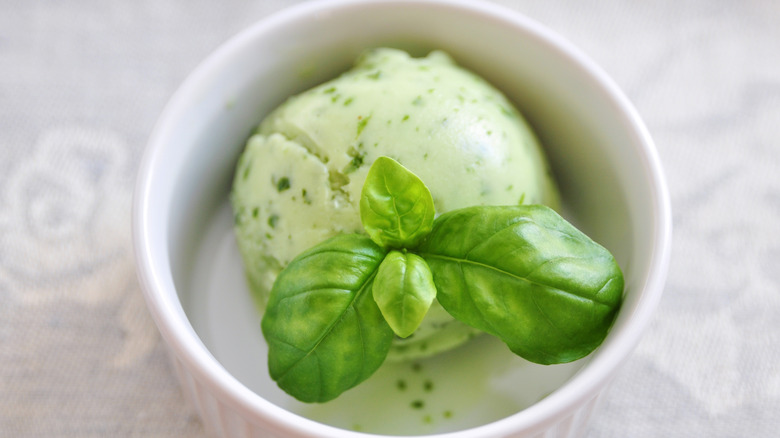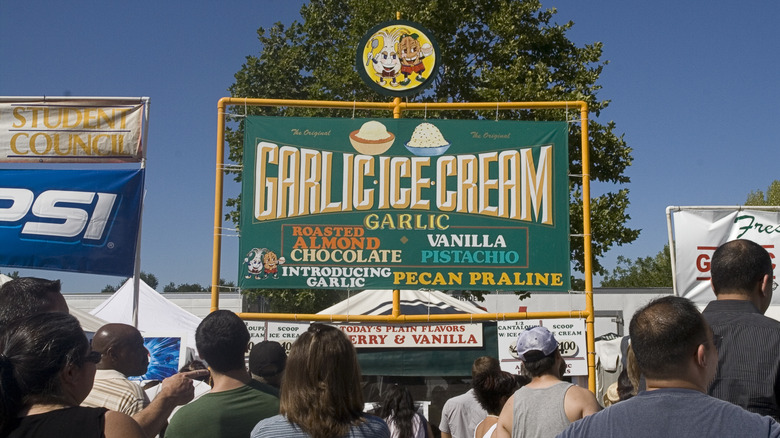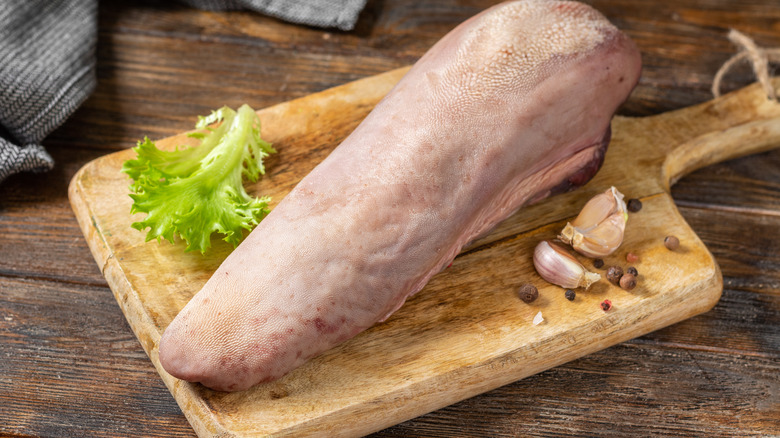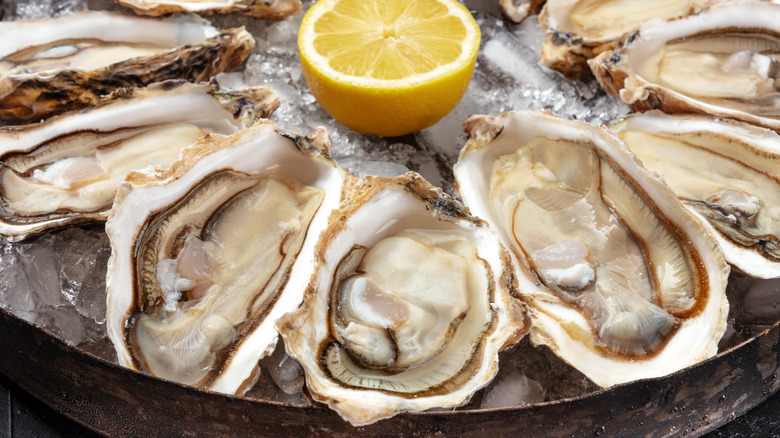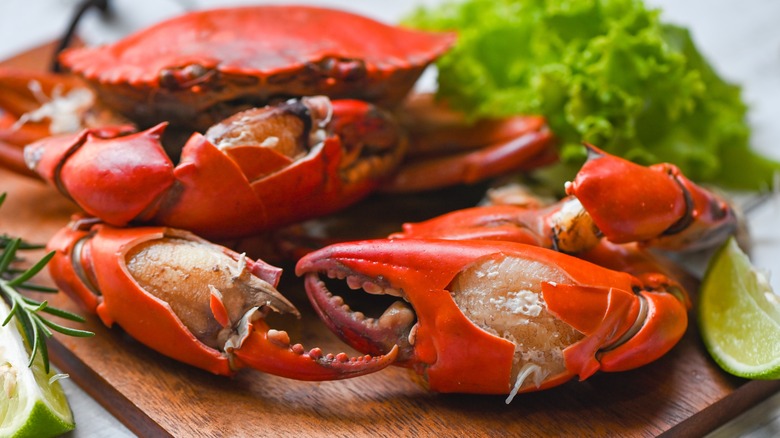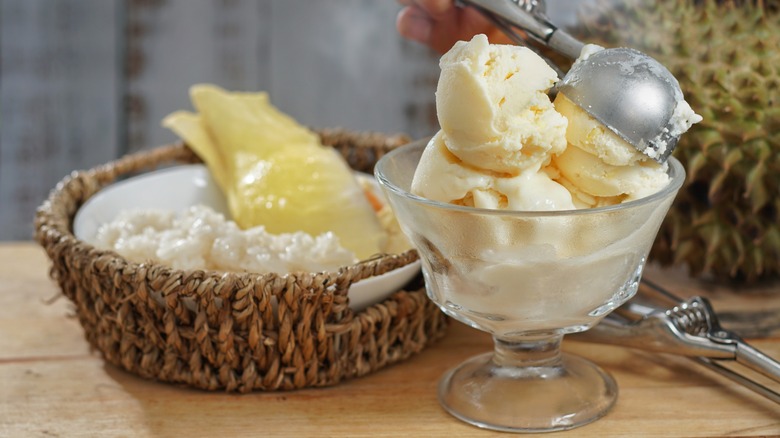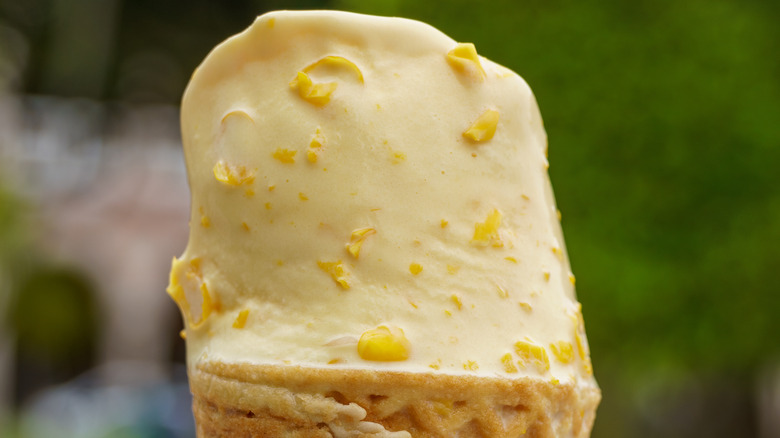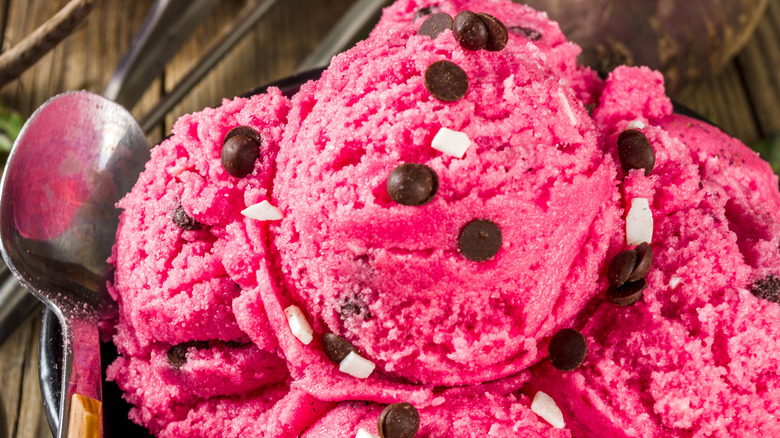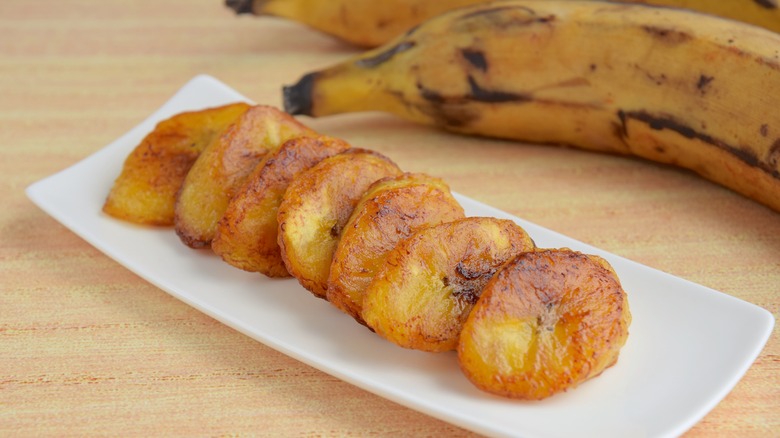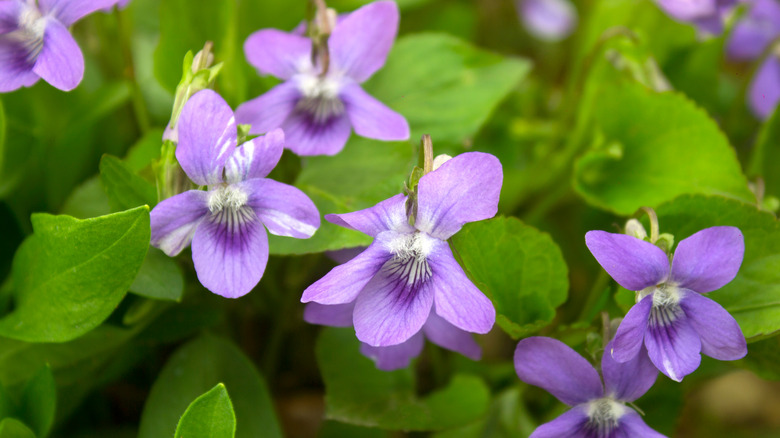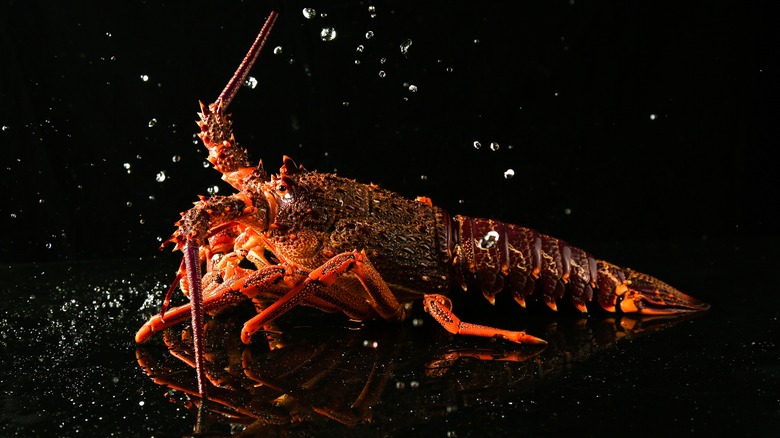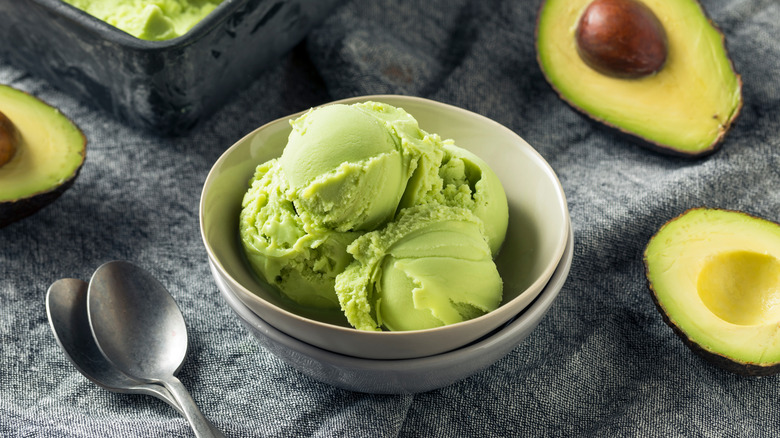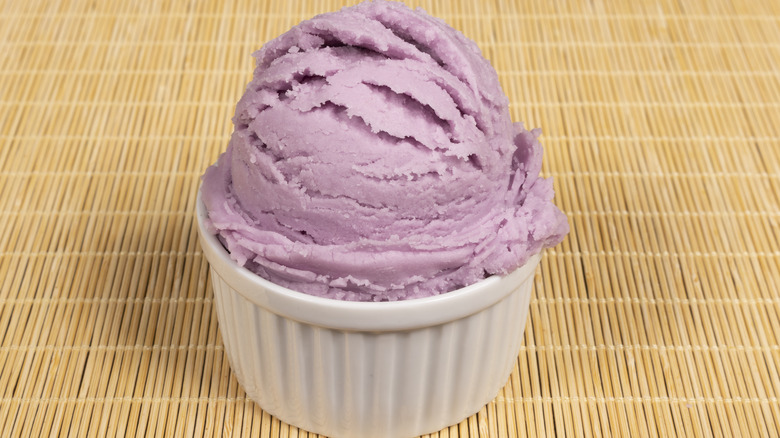15 Ice Cream Flavors You Never See On The Menu
Who doesn't love ice cream? The frozen treat is beloved all around the world. You can enjoy it fried, as a sandwich, in a cone, atop a tall glass of root beer, on a waffle, in a sundae, or entirely unto itself. It comes in a wide array of forms, ranging from rich Italian gelato to varieties made with non-dairy milk. And then there are the flavors. They number in the thousands, and new ones are dreamed up every day. Freezer aisle creativity is so intense, in fact, that unexpected ice cream flavors are basically their own industry, and nothing is off-limits — we're talking ice cream that tastes like Thanksgiving turkey, pear and blue cheese, and 24-karat gold leaf.
And yet, somehow, certain flavors never seem to pop up on the menu. Some are absent because they're simply bizarre, some are hard to make, and some were once hot ticket items before falling into obscurity. From floral concoctions to savory oddities, we're here to take a look at the 15 ice cream flavors you never see on the menu.
Basil
When you think of refreshing ice cream that tends to come in shades of green, you probably think of a mint-flavored cone that may or may not be studded with chocolate chips. No one can blame you: Mint and ice cream is a match made in dairy heaven, and the perfect thing for a sweltering summer day. But it's not the only option. Something else in the ice cream freezer comes straight from the herb garden, and it's just as cool, green, and fresh: basil ice cream.
Basil is most famously used in savory dishes like caprese salad and pasta with pesto sauce, so if you're balking at the mere idea of this herb in your ice cream, we can't blame you. But take a moment to leave all dinnertime associations behind. Basil is crisp, bright, and ever-so-slightly sweet, just like mint. Moreover, while you're not likely to encounter it at your local ice cream parlor, it actually has a pretty long history of being used in desserts: Basil sorbet, basil candy, and basil cordial are all entirely real and absolutely delicious. Consider seeking out basil ice cream, or making it yourself the next time the thermometer rises — you just might find a new herbal favorite.
Beer
Alcoholic ice cream has gone from being a rare creation of cutting-edge kitchens to the sort of thing you can find in your typical frozen food aisle, next to the pints of Rocky Road. But boozy flavors are not created equal: You're a lot more likely to run into a limoncello-spiked sundae than one made with beer-flavored ice cream. But indeed, beer-flavored ice cream exists.
In taste, beer ice cream reflects the beers it was made with. Stout-based flavors, for example, are full of the rich malty goodness that characterizes the brew, while ice cream made with brown ale is warm and nutty. If you're lucky enough to run into different kinds of beer ice cream, you can pretty much guess which flavor you'll favor based on your beverage preferences — and, perhaps just as importantly, which ones you'll loathe. What tastes like a bitter, hoppy nightmare to one gourmand might be heaven to another. But hey, that's the beauty of beer, now in frozen form.
Garlic
Garlic is as pungent as it is popular. The world can't get enough of the stuff when it appears alongside noodles, poultry, rice, vegetables, red meat, tubers, or just about anything else ... as long as it's savory. Dessert, however? That tends to be a garlic-free zone.
Enter garlic ice cream. This unique flavor is rarely seen on supermarket shelves, but dedicated events like the legendary Gilroy Garlic Festival often serve it up alongside more conventional treats like garlic bread and pizza. Believe it or not, a significant number of people find it delicious. As one attendee of the North Quabbin Garlic and Arts Festival remarked to the Worcester Telegram, "It's fantastic, it's real good." Some disagree, of course – one Redditor summed this opinion up neatly by reporting, "Tried it while I was in Gilroy. It's worse than you think." Maybe this divided opinion is a good thing, when you think about it — if garlic was delectable in every culinary arena, we might never eat anything else.
Beef tongue
Yes, you read that right: Beef tongue ice cream exists — in Japan, at least. You can find this one-of-a-kind flavor in Ice Cream City, an offbeat parlor that's part of the wider NamjaTown theme park complex. Ice Cream City specializes in weird flavors: In addition to beef tongue, you can also get ice cream in wasabi, octopus, snake, pearl, coal, and tulip flavors. Some of these oddball varieties are inoffensive and even tasty, according to intrepid travelers. But beef tongue stands apart as a truly weird creation.
As one travel blogger put it, "The beef tongue was ... not surprising, but pungent. There were in fact small pieces of actual beef tongue in it, so while the ice cream simply tasted like milky beef stew, the meat pieces tasted like chunks of beef that had been boiled in water so that most of the flavor was gone." If you can get past the inherent weirdness of beef tongue ice cream, this doesn't sound totally unpleasant. It's basically a rich entrée that happens to have been frozen. In truth, the most offensive part of this description is the tasteless beef chunks — if you're going to make beef tongue ice cream, you should take care not to cook all the savory deliciousness out of the actual beef. But even if the chunks were simmered to perfection, we'd probably give this a pass. Some foods just weren't meant to be ice cream-ified.
Oyster
Though popular, especially in seaside regions, oysters remain something of an acquired taste. Oyster ice cream, on the other hand? You might already be assuming that's a taste no one could acquire. Few would blame you. Who could possibly be into a mollusk-flavored dessert?
There's actually a concrete answer to that question: Certain people who lived during the 19th century. In 1824, a homey little cookbook called "The Virginia Housewife" featured a recipe for oyster ice cream. It leans more towards the savory side of things, which might make it a bit more palatable — if you think of it as a frozen chowder, it's almost appealing. However, oyster ice cream doesn't seem to have ever been a truly big deal. Though the internet is full of fanciful stories of the dessert at the first Thanksgiving and various presidents' tables, they're all pretty much bunk.
That said, modern oyster festivals have taken to serving the oceanic confection. We'll say one thing for it: As a combination of a classic boardwalk treat and a staple of shoreline cuisine, it's basically summer in a cone. Still, we'll be sticking to chocolate.
Crab
Crab is a wonderfully versatile food. You can turn the culinary crustacean into creamy bisques, craggy crab cakes, fragrant dips, and inimitable ice cream. Wait — ice cream? Yep.
Crab ice cream is real, and it's actually got some passionate fans. This unique creation is tied to a few specific places: Japan, where it sits comfortably alongside squid and octopus ice cream; Coromoto, a Venezuelan ice cream parlor famous for its dizzying array of out-there flavors; and The Fat Duck, an elite English restaurant owned by celebrated chef Heston Blumenthal.
Blumenthal is by far this dish's greatest champion. He maintains that people's initial revulsion is based on their own assumption that it must be a conventionally sugar-laden confection. "If you give someone a spoonful of this and tell them that it's crab ice cream, they'll recoil," the chef wrote for The Guardian. "But tell them that it's frozen crab bisque, and they'll eat it without a fuss." He might be onto something: Food critics have hailed his crab ice cream as a memorable exploration of the crustacean's briny, mild, and ever-so-slightly fruity flavor. Crab ice cream might not be as popular as crab cakes, but it's definitely earned a space in the world of haute cuisine.
Durian
Durian is controversial. Many are repulsed by its unique smell, which is often compared to sewage, turpentine, sweat, and rancid meat. This odor isn't just unpleasant, either — it's strong, to the point that durians are banned from Singapore's Mass Rapid Transit system. But durian lovers claim its sweet, custardy flesh is so delicious, it's worth enduring such a stench. 19th century naturalist Alfred Russel Wallace painted a particularly delectable portrait of the fruit: "This pulp is the eatable part," he wrote of the durian's smooth interior, "and its consistence and flavour are indescribable. A rich custard highly flavoured with almonds gives the best general idea of it." Pretty positive, right? But then he goes on, writing, "but there are occasional wafts of flavour that call to mind cream-cheese, onion-sauce, sherry-wine, and other incongruous dishes." Yikes.
Suffice it to say, durian is unique. So is durian ice cream. You're not likely to find it at your local parlor, unless you're in Southeast Asia, but a quick internet search does reveal hundreds of recipes for the attention-grabbing treat. Clearly, it has fans ... but not enough to affect what the average Western ice cream company sells. That said, this may be changing: Indie brand Mavens Creamery has managed to get its durian ice cream into certain Costco locations.
Sweet corn
It's honestly pretty weird that sweet corn doesn't make many appearances on the dessert table. High-fructose corn syrup is a common source of sugar in many sweet treats, after all — why can't we make the jump to offering corn-flavored cake, pie, and pastries? Ice cream is an especially ideal dish to feature this much-beloved cereal grain; if there are two foods that symbolize summertime, they're freshly-shucked ears of sweet corn and dripping ice cream cones.
Some corners of the world are a bit more amenable to corn ice cream than others. In South Korea, for example, you can enjoy corn-flavored ice cream studded with actual niblets, encased in a cob-shaped wafer shell. According to food blogger Daniel Gray of Seoul Eats, however, it's not much to write home about: "So how did it taste? Sorta like soggy popcorn that fell on a pile of yellow snow," he remarked. "Gross." This is disappointing, but thankfully, other companies and cooks have made more impressive attempts at marrying maize and ice cream. Recipes are all over the internet, and independent parlors often experiment with the sunny flavor. If we're lucky, sweet corn ice cream might be the next summer staple.
Buttermilk
Most people only know buttermilk as an ingredient in pancakes, biscuits, and fried chicken. The idea of it as a treat unto itself, especially in ice cream form, is pretty strange — but it shouldn't be. Wait a minute, those who've accidentally taken a swig from the carton, thinking it was normal milk, might protest. "Buttermilk tastes weird!" Indeed, it's sour, tangy, and ripe-tasting, due to the fermentation that creates it. How could that create a desirable ice cream flavor? Who's out there looking for a cone that can be described as "funky"?
The truth is, buttermilk ice cream probably won't become a hot flavor any time soon. But it's not actually as out-there as you might think. Consider the existence of cheesecake, a dessert adored by millions. People love cheesecake for its sweetness, creaminess, smoothness ... and its unique tang. Cheese danishes, cream cheese brownies, and cannoli are also beloved for similar reasons. Buttermilk ice cream is right in line with these sweets; the only real difference is that it derives its uniquely tangy flavor from buttermilk rather than ricotta or cream cheese. You're probably never going to become the kind of person who pours themselves a tall glass of buttermilk to enjoy on its own, but you might be a lot more amenable to buttermilk ice cream than you ever realized.
Beet
Beets and ice cream? This might sound like a crazy combo, but it's actually pretty sensible. Sure, beets are at the heart of such classic savory dishes as borscht, salad, and biff a la Lindstrom. But remember, beets — specifically, sugar beets – account for roughly 30% of global sugar production. So yeah, beet ice cream isn't as wacky a prospect as you might expect. But is it good?
Enterprising Reddit users who have created this bright pink treat report that it is, in fact, uniquely delectable. Over on r/icecreamery, user GGxGG remarked, "It turned out great! The color is gorgeous, and it has an earthy, interesting taste that my husband thought tasted reminiscent of butterscotch. The texture after hardening was very soft and creamy, scoopable right out of the freezer." Butterscotch is a perennially popular flavor for all manner of sweets, and a comparison to its warm, caramel-y goodness is a major mark in beet ice cream's favor. The fact that it doesn't require thawing makes it even more impressive. Those with a passion for homemade ice cream should consider adding beet to their to-make list of flavors — just be sure to have the bleach ready to handle any pink stains a dripping cone might leave.
Sweet plantain
Plantains are a culinary workhorse. They dazzle as a savory starch in the form of tostones, alloco, and mofongo, yet they also impress when transformed into a dessert. Sweet fried plantains, commonly known as maduros, are a particularly beloved treat in Cuban kitchens. These sticky, caramelized chunks of deliciousness make an ideal ice cream mix-in, but you're not likely to find it at a parlor near you. If plantain fans want to combine the delicious fruit with a frozen dessert, they're a lot more likely to pile ice cream atop their maduros and drizzle a sweet sauce on top.
This tropical sundae is, of course, delicious, and the internet is full of intriguing variations that incorporate different seasonings and syrups. But why aren't people putting plantains in their ice cream? One parlor, at least, is brave enough to do so: Miami's Azucar Ice Cream Company, which specializes in Cuban flavors. "The Plantain Ice Cream is actual fried plantains that you would have with your meal," company representative Patricia Delarosa told WSVN-TV, "and we take it, and we blend it well and put some bits and pieces in there." Could plantain ice cream catch on in places that can't tell maduros and mofongo apart? We think yes, if only some company were brave enough to try.
Violet
Flowers have a long culinary history, and violets stand at the forefront of it. These bright purple blossoms, which spread across meadows, forests, and lawns as springtime breaks upon the land, are entirely edible, and suitable for use in everything from salads to jelly. They have a particularly long history in the world of sweets: Candied violets, violet honey, and violet-flecked pound cakes are all tried-and-true delights. It's no surprise, then, that violet ice cream exists — but your chances of trying it depend of your proximity to a few adventurous ice cream parlors or your own gumption as a home cook.
On her blog, Make Gather Grow, Mari Jyväsjärvi Stuart chronicled the process of gathering wild violets, creating violet syrup, and using it to make violet ice cream. What's the verdict? Pretty delicious: "This ice cream is wild and sweet, just like the season of spring," Stuart noted. "The violet flowers add a delicate flavor that makes you think of a green spring meadow." Not interested in churning your own ice cream? If you happen to be a Scot living near Stirling, you can head on over to dessert mecca Urban Bubble and try their Parma Violets ice cream, which is inspired by the classic British candy of the same name. Summer might seem like the classic season for frozen desserts, but violet ice cream makes a strong case for springtime.
Lobster
Lobster is a high-class choice for any discerning diner and a staple of many regions' cuisine. As an ice cream flavor, though? Few people might line up for this shellfish-studded treat, but let us assure you, it is entirely real.
As you might expect, this flavor comes from Maine — specifically, Bar Harbor. This lovely town is most famous as the gateway to Acadia National Park, one of the United States' most gorgeous locales. Thousands of tourists pass through Bar Harbor all year long, but the crowds are especially thick in the summer. What better way to catch their attention than combining the hottest part of the year's signature dessert and Maine's most famous culinary offering?
Enter Ben and Bill's Chocolate Emporium. For the most part, this establishment sells normal sweets ... but it's also become notorious for its lobster ice cream. This flavor keeps things pretty simple: It's plain vanilla ice cream, studded with chunks of luscious lobster meat. Is it good? One testimonial on the company's website raves, "Long lines in the summer but well worth waiting for their lobster ice cream. Yup, you heard that right. LOBSTER ice cream! ... Delish!" No matter what you might think of this out-there creation, you have to admit it's gutsy. And, given the flavor has endured on the menu for decades, it's kept people coming back for more.
Avocado
Avocado shows up in all sorts of desserts nowadays. For the most part, though, these sweet treats don't feature avocado as a flavor unto itself, but as a way of adding fat and moisture. Fudgy avocado pudding and avocado brownies don't really taste like the inimitable fruit — they just taste like chocolate. But avocado ice cream bucks this trend by putting the avocado front and center.
Even those who gobble avocado toast down like there's no tomorrow might not leap at the chance to try this one-of-a-kind creation, however. While avocados are undoubtedly rich, they're not very sweet, boasting a mellow, vegetal taste. Even adventurous ice cream fans have trouble falling in love with this flavor: As one Reddit user who crafted the pale green treat remarked, "This is an interesting one. Good, but not quite my thing. It's super heavy on avocado flavor so I can only get through 2 spoonfuls before I've had enough." Perhaps a version that leans into being savory might work a little better. Add in some chopped onions and lime juice, and you could even have the first ice cream suitable for eating with tortilla chips.
Grape
Have you ever seen grape ice cream for sale? Probably not ... and isn't that kind of weird? Grapes are enormously popular all over the world, after all. Similarly beloved fruits like strawberries, cherries, and peaches pop up in ice cream parlors all the time. People aren't averse to consuming grapes in processed form, either — we're been imbibing wine since ancient times. So why is the fruit of the vine absent from our ice cream cones?
There are a few reasons for this. For one thing, grapes' water content makes them hard to transform into velvety ice cream. As food writer Ja-ne de Abreu told Reader's Digest, "The texture would be off and not so creamy." This is a pretty gigantic problem to face right out of the gate: Nobody wants ice cream full of frozen grape shrapnel. Their acidity adds an extra hurdle; if it isn't specifically deal with, it curdles the dairy that makes ice cream what it is. Then there's the fact that too much processing takes away from grapes' distinct color and flavor. Making grape ice cream is a gauntlet few want to subject themselves to, given the fact that there's little demand. For boutique creameries and home cooks, however, it's an interesting challenge. Just be sure to deal with the acid problem before blending fruit and dairy together, lest you end up with curdled grape sludge.

